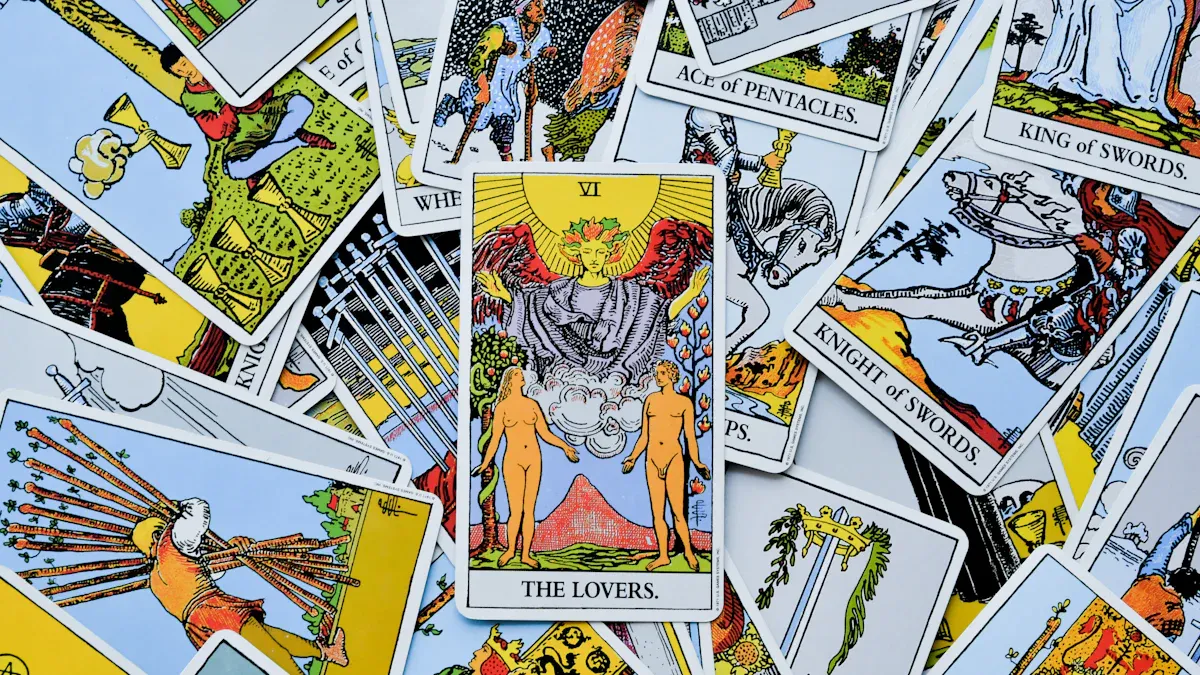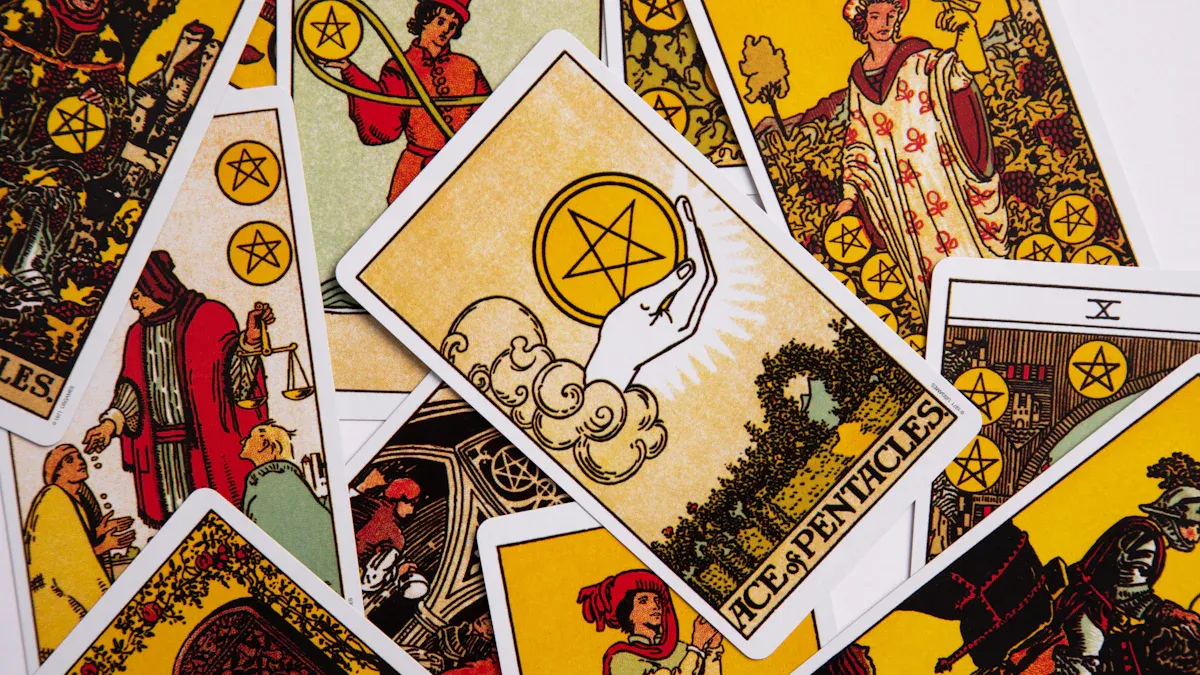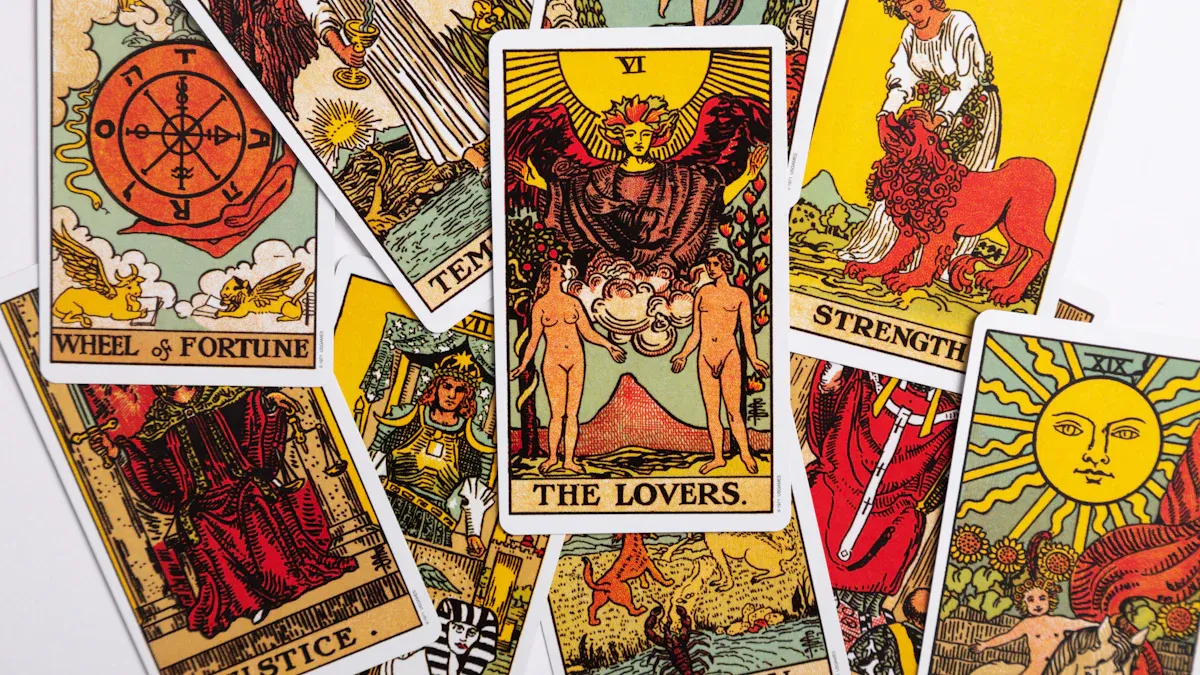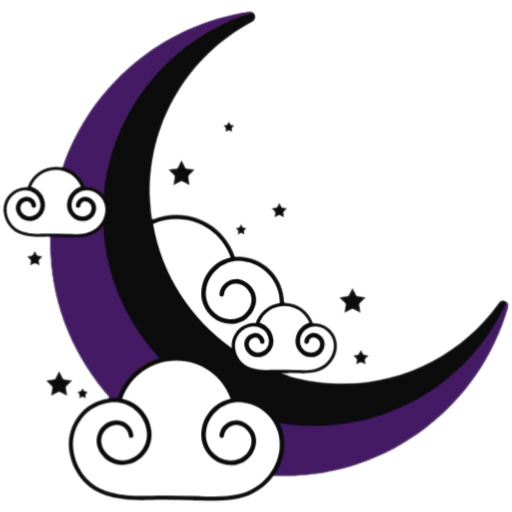
A tarot deck is like a storybook filled with symbols and meanings. It’s divided into two parts: the Major Arcana and the Minor Arcana. The Major Arcana has 22 cards, each representing big life themes, like “justice” or transformation. The Minor Arcana, with its 56 cards, focuses on everyday events and emotions. Did you know the Minor Arcana first appeared in Italy during the 1440s as part of card games? Over time, these cards evolved into tools for divination. Understanding the tarot card order helps you connect with the deck’s deeper symbolism and makes it easier to put tarot cards back in order after a reading.
Key Takeaways
A tarot deck has two parts: Major Arcana and Minor Arcana. Each part helps in different ways during readings.
The Major Arcana shows a journey of personal growth. It starts with The Fool and ends with The World, teaching big life lessons.
The Minor Arcana is about daily life. It has four suits: Wands, Cups, Swords, and Pentacles. Each suit stands for a part of life.
Knowing the card order makes readings better. It shows links between past, present, and future events.
Try using stories or memory tricks to learn the card order. This makes reading tarot easier and more fun.
The Major Arcana Tarot Cards: Order and Meaning

What Is the Major Arcana?
The Major Arcana is the heart of any tarot deck. These 22 cards represent the big moments in life—those turning points that shape who you are and where you’re headed. Unlike the Minor Arcana, which focuses on daily events, the major arcana tarot cards dive deep into life’s bigger picture. They symbolize profound life lessons, karmic influences, and archetypal themes that guide your journey toward enlightenment. Think of them as a roadmap for personal growth, offering guidance when you’re at a crossroads.
Each card in the Major Arcana carries a unique message. For example, the Magician encourages you to harness your skills and take action, while the High Priestess reminds you to trust your intuition. The Empress speaks of nurturing and creativity, and the Emperor teaches you about structure and authority. Together, these cards tell a story of transformation and self-discovery, often referred to as the Fool’s Journey.
The Correct Order of the Major Arcana
Cards 0–10: The Fool’s Journey Begins
The Major Arcana begins with The Fool, card 0, symbolizing new beginnings and the courage to step into the unknown. As the Fool embarks on his journey, he encounters various archetypes that teach him valuable lessons:
The Magician shows him how to manifest his desires.
The High Priestess introduces him to the power of intuition.
The Empress nurtures his creativity and connection to nature.
The Emperor provides structure and stability.
The Hierophant guides him through tradition and spiritual wisdom.
The Lovers teach him about relationships and choices.
The Chariot represents his determination to achieve his goals.
The Hermit encourages introspection and self-awareness.
The Wheel of Fortune reminds him of life’s ups and downs.
Death marks transformation and the end of one phase, paving the way for a new beginning.
Cards 11–21: The Journey’s Completion
The second half of the Major Arcana reflects the Fool’s deeper understanding of life. Temperance teaches balance, while the Devil challenges him to confront his limitations. The Tower shakes his foundations, forcing him to let go of false beliefs. The Star offers hope and renewal, and the Moon helps him face his fears. The Sun brings clarity and joy, leading to Judgment, where he reflects on his journey. Finally, The World signifies completion and the fulfillment of his purpose.
Why the Major Arcana Order Matters
The order of the major arcana tarot cards isn’t random. It tells a story—a journey of personal growth and transformation. Starting with The Fool, the sequence mirrors the trials and triumphs you face in life. Each card builds on the lessons of the previous one, creating a narrative that helps you understand your path. In a tarot reading, this order provides context, showing how different phases of your life connect and evolve. By learning the meaning of major arcana and their sequence, you can unlock deeper insights into your life’s direction.
The Minor Arcana: Suits and Their Tarot Card Order

What Is the Minor Arcana?
The Minor Arcana is the part of the tarot deck that focuses on the smaller, everyday moments of life. While the Major Arcana deals with big-picture themes, the Minor Arcana dives into the details—your emotions, challenges, and daily experiences. It’s made up of 56 cards divided into four suits: Wands, Cups, Swords, and Pentacles. Each suit connects to one of the classical elements—fire, water, air, and earth—and represents a different aspect of life.
Unlike the Major Arcana, the Minor Arcana feels more relatable because it reflects the ups and downs you face every day. Whether it’s a tough decision, a burst of creativity, or a moment of emotional clarity, these cards capture it all. The numbered cards (Ace to Ten) and court cards (Page, Knight, Queen, King) within each suit add layers of meaning, often using numerology to deepen their symbolism.
The Four Suits of the Minor Arcana
Wands: Fire and Creativity
The Suit of Wands represents action, passion, and growth. It’s tied to the element of fire, symbolizing energy and creativity. These cards often appear when you’re starting a new project or chasing a goal.
Cups: Water and Emotions
Cups are all about feelings, relationships, and intuition. Linked to the element of water, this suit reflects your emotional world. It’s the suit that speaks to love, spirituality, and the heart’s desires.
Swords: Air and Intellect
The Suit of Swords focuses on the mind—your thoughts, decisions, and challenges. Associated with the element of air, these cards often highlight moments of clarity or conflict. They encourage you to think critically and face the truth.
Pentacles: Earth and Material Aspects
Pentacles deal with the material world. Connected to the element of earth, this suit represents money, career, and physical well-being. It’s about building stability and enjoying the fruits of your labor.
The Order Within Each Suit
Numbered Cards: Ace to Ten
The numbered cards in each suit follow a clear progression. Each number carries a unique meaning, blending numerology with the suit’s element. For example:
Twos represent balance and partnership.
Tens signify completion and fulfillment.
This order helps you understand how situations evolve, from the spark of an idea (Ace) to its ultimate outcome (Ten).
Court Cards: Page, Knight, Queen, King
The court cards represent people or personality traits. Pages often symbolize curiosity and learning. Knights bring action and movement. Queens embody wisdom and nurturing, while Kings represent mastery and leadership. Together, they offer insight into roles you play or people influencing your life.
The Minor Arcana’s structure, with its suits and card order, creates a detailed map of life’s everyday experiences. By learning this structure, you can uncover deeper meanings in your tarot readings.
Why Does the Tarot Card Order Matter?
Learning the Structure of the Deck
Understanding the tarot card order helps you see the deck as more than just a collection of random cards. Each card has a specific place and meaning, creating a structure that mirrors life’s journey. When you know this structure, you can approach the deck with confidence. For example, the Major Arcana follows a clear progression, starting with The Fool and ending with The World. This sequence reflects personal growth and transformation. Similarly, the Minor Arcana suits follow a logical order, from the Ace to the King, showing the evolution of ideas, emotions, challenges, and achievements.
By learning the order, you’ll also find it easier to organize your deck after a reading. This practice reinforces your understanding of the cards and their relationships. It’s like learning the alphabet—once you know it, everything else becomes easier.
Using the Order in Tarot Readings
The tarot card order plays a key role in interpreting spreads. When you draw cards, they often reveal a story that moves from the past to the present and then to the future. Knowing the order helps you understand how these phases connect. For instance:
Cards discussing the past provide context for the present situation.
They highlight struggles or obstacles that influence your current path.
This foundation ensures you don’t rush to future interpretations without understanding the full picture.
When you grasp the card order, your readings become more insightful. You’ll notice patterns and themes that might otherwise go unnoticed, giving you a deeper connection to the messages in the cards.
Symbolism and Storytelling in the Card Order
The tarot card order isn’t just about structure—it’s also a tool for storytelling. Many readers use the cards to create narratives that resonate with their lives. For example:
A three-card spread can tell a past-present-future story, even without assigned positions.
You might also craft an action-outcome narrative, showing how decisions lead to results.
The Fool’s Journey is another powerful example. This cyclical story helps you understand where you are in your personal journey and what lies ahead. Each card builds on the one before it, creating a rich tapestry of symbolism and meaning. By embracing this storytelling aspect, you can unlock the deeper wisdom of the tarot.
Tip: Think of the tarot card order as a map. It guides you through the deck’s layers of meaning, helping you uncover the connections between your past, present, and future.
Tips for Memorizing the Tarot Card Order
Breaking the Deck into Sections
Memorizing all 78 tarot cards might feel overwhelming at first, but breaking the deck into smaller sections makes it much easier. Think of it like organizing a bookshelf—you group similar books together to find them faster. Here’s how you can do the same with your tarot deck:
Create a Memory Palace: Imagine a familiar place, like your home, and assign each Major Arcana card to a specific spot. For example, The Fool could stand at your front door, ready to step into the unknown.
Focus on a Few Cards at a Time: Don’t rush. Start with one or two cards, and once you’re comfortable, add more.
Use Mnemonic Images: Picture something vivid for each card. For instance, imagine The Magician holding a glowing wand to symbolize creativity.
Tell Stories: Connect the cards through a narrative. Maybe The Fool meets The Magician, who teaches him how to use his tools, before encountering The High Priestess.
Review Regularly: Revisit your associations often. This helps reinforce your memory and keeps the order fresh in your mind.
Breaking the deck into sections not only simplifies the process but also helps you build a stronger connection with the cards.
Using Mnemonics and Associations
Mnemonics are a fun and creative way to remember the tarot card order. They work by linking the cards to something familiar or memorable. Here are a few ideas to try:
Make Associations: Tie each card to a concept you already know. For example, connect The Lovers card to a romantic movie or couple you admire.
Visualize a Memory Palace: Picture the cards in a specific order within a familiar space, like walking through a park and seeing each card as a statue along the path.
Craft Stories: Build a narrative that links the cards together. For instance, imagine Pete Townsend (from The Who) playing his guitar in front of The Tower card, symbolizing chaos and change.
These techniques turn memorization into a creative exercise. The more vivid and personal your associations, the easier it becomes to recall the cards.
Practicing with the Cards Regularly
Practice makes perfect, especially when it comes to tarot. The more you work with your deck, the more familiar the card order will become. Here are some simple exercises to try:
Quick Draws: Shuffle your deck and flip over one card at a time. Say its name and meaning out loud. This builds speed and confidence.
Spread Building: Combine two decks and create a story using the top cards. This helps you see how the cards connect and flow together.
Self Check-In: Reflect on your own life experiences and relate them to the suits of the Minor Arcana. For example, think about a recent creative project (Wands) or a tough decision (Swords).
By practicing regularly, you’ll not only memorize the card order but also deepen your understanding of their meanings. It’s a win-win!
Tip: Keep your deck nearby and practice whenever you have a spare moment. Even five minutes a day can make a big difference.
Understanding the order of a tarot deck connects you to its deeper meanings. The Major Arcana reveals life’s big lessons, while the Minor Arcana focuses on daily experiences. Each suit in the Minor Arcana ties to an element, helping you interpret the cards with clarity. Mastering the tarot deck’s structure enhances your readings by making interpretations more intuitive and accurate. You’ll also uncover relationships between cards, enriching your practice. Whether you’re a beginner or experienced reader, knowing the card order transforms how you connect with your tarot deck.
FAQ
What is the best way to learn the tarot card order?
Start small! Break the deck into sections like the Major Arcana and each Minor Arcana suit. Focus on a few cards daily. Use storytelling or mnemonics to make it fun. Practicing regularly with your deck will help you remember the order naturally.
Tip: Keep your deck nearby for quick practice sessions!
Do I need to memorize the tarot card order to do readings?
Not necessarily! While knowing the order helps you understand the deck’s structure, you can still do readings without memorizing it. Over time, as you work with the cards, their order and meanings will become more familiar.
Why does the tarot card order start with The Fool?
The Fool represents new beginnings and unlimited potential. It’s the perfect starting point for the Major Arcana’s story, known as the Fool’s Journey. This journey mirrors personal growth, making The Fool the ideal symbol for stepping into the unknown.
Can I shuffle the deck without ruining the card order?
Absolutely! Shuffling doesn’t ruin the order. After a reading, you can reorganize the cards if you want to reset the deck. Many readers enjoy this process as it helps them reconnect with the cards and their meanings.
How long does it take to memorize the tarot card order?
It depends on your learning style and practice. Some people memorize it in weeks, while others take months. Consistency is key. Spend a few minutes daily reviewing the cards, and you’ll notice progress before you know it!
Note: Don’t rush—enjoy the process of connecting with your deck.


